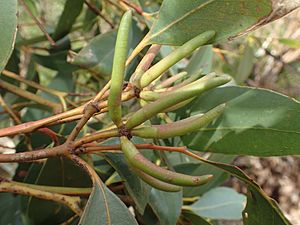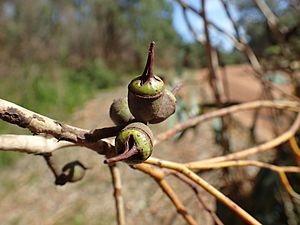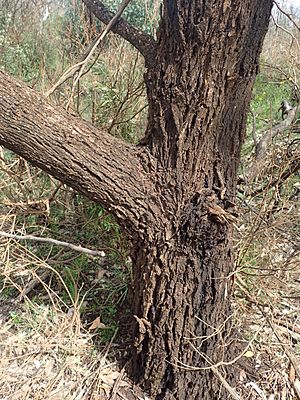Yeate (tree) facts for kids
Quick facts for kids Yate |
|
|---|---|
 |
|
| Eucalyptus cornuta near Walpole | |
| Scientific classification | |
| Genus: |
Eucalyptus
|
| Species: |
cornuta
|
| Synonyms | |
|
Eucalyptus macrocera Turcz. |
|
The Yate (scientific name: Eucalyptus cornuta) is a special type of tree. It is also sometimes a mallee, which means it grows as a shrub with many stems from the ground. This tree is found only in the southwest part of Western Australia.
The Yate tree has rough, stringy bark on most of its trunk. Higher up, the bark is smooth. Its adult leaves are shaped like a spear. The tree produces long flower buds, usually in groups of eleven or more. Its flowers are yellowish, and its fruit is shaped like a cylinder or a cup. The Yate is grown in many places because it produces some of the hardest and strongest wood in the world.
Contents
What the Yate Tree Looks Like
The Eucalyptus cornuta is a tree that usually grows up to 25 meters (about 82 feet) tall. Its top, called the crown, can be 8 to 12 meters (26 to 39 feet) wide. Sometimes, it grows as a mallee, reaching about 10 meters (33 feet) tall. It has a special woody swelling at its base called a lignotuber. This helps new stems grow if the main trunk is damaged.
The bark on the trunk is rough and stringy, ranging from brown to almost black. Higher up, the bark is smooth and grayish. Young plants and new shoots from the lignotuber have leaves shaped like an egg or nearly round. These leaves are 40 to 70 millimeters (1.6 to 2.8 inches) long and 20 to 70 millimeters (0.8 to 2.8 inches) wide. They are lighter in color on the underside.
Adult leaves grow in an alternating pattern along the stem. They are shiny green on both sides and usually spear-shaped. These leaves are typically 60 to 135 millimeters (2.4 to 5.3 inches) long and 10 to 33 millimeters (0.4 to 1.3 inches) wide. They grow on a small stalk called a petiole, which is 5 to 20 millimeters (0.2 to 0.8 inches) long.
The flower buds grow in groups of eleven or more. They are found on a rounded or flat stalk called a peduncle, which is 12 to 32 millimeters (0.5 to 1.3 inches) long. Each bud usually sits directly on the stalk without its own small stem. Mature buds are long, 23 to 42 millimeters (0.9 to 1.7 inches) long and 5 to 8 millimeters (0.2 to 0.3 inches) wide. They have a horn-shaped cap, called an operculum, which is much longer than the base of the flower.
Yate trees flower between January and May, or from July to November. The flowers are yellowish-green. The fruit is a woody, cylinder-shaped or cup-shaped capsule. It is 5 to 12 millimeters (0.2 to 0.5 inches) long and 6 to 13 millimeters (0.2 to 0.5 inches) wide. The seeds are released through small openings in the fruit.
How Yate Got Its Name
The Eucalyptus cornuta was first officially described in the year 1800 by a scientist named Jacques Labillardière. He collected a sample of the tree, called a type specimen, from some rocky areas on Observatory Island. This happened on December 13, 1792, during an expedition led by Antoine Bruni d'Entrecasteaux. Labillardière wrote about the tree in his book, Relation du Voyage à la Recherche de la Pérouse.
The second part of the scientific name, cornuta, is a Latin word. It means "horned" or "having horns." This name refers to the horn-shaped cap (operculum) on the flower buds.
In the Nyungar language, spoken by Indigenous people in southwest Australia, the Yate tree has several names. These include mo, yandil, yeit, or yate.
"Yate" is a common name for this tree, and it's also used for several other types of eucalypts in Western Australia. Some examples are:
- Bushy yate (E. lehmannii)
- Flat-topped yate (E. occidentalis)
- River yate (E. macrandra)
- Warty yate (E. megacornuta)
Where Yate Trees Grow
Yate trees grow in an area southeast of Busselton all the way to Cape Arid National Park and the islands of the Recherche Archipelago. These trees often grow in separate groups, not spread out everywhere. In drier areas near Esperance, you can often find them near granite outcrops. They grow in deeper, wetter soil found in hollows or at the base of these rocky areas.
Along the coast, the Yate tree often grows as a large mallee. In places with a lot of rain and rich soil in valleys, especially inland from Manjimup to the Porongurups, it can grow into tall trees. The Yate tree grows quickly when it's young. Its lignotuber helps it grow new stems after a fire or when it gets more space and light.
The way it grows is similar to smaller mallee eucalypts found in drier regions. It also looks like the limestone marlock (E. decipiens), which grows to the north and east. In good growing conditions, a single Yate trunk can become very tall. It can even compete with other tall forest trees like jarrah (Eucalyptus marginata) and marri (Corymbia calophylla). However, it usually doesn't grow as tall as the giant karri trees (Eucalyptus diversicolor).
How People Use Yate
Yate in Gardens and Parks
The Yate tree is sold for planting in gardens and parks. People use it as an ornamental tree, for shade, or to provide a home for wildlife. It can handle dry weather, some frost, and different types of soil. It also grows well in coastal areas.
Even though it can grow very tall in its natural home, the Yate tree is also successfully planted as a medium or small tree. It's great for providing shade and acting as a windbreak. You can also see it planted along streets or highways. The E. cornuta is well-known as a cultivated tree across Australia and has also been brought to California. In 1879, a scientist named Ferdinand von Mueller sent Yate seeds to Lucknow. There, the young trees grew very quickly and could handle tropical rain, unlike other eucalypts tested.
Other Uses for Yate
This type of eucalypt produces some of the hardest and strongest wood in the world. In the past, this wood was used to make parts for wheels and the shafts of horse-drawn vehicles. However, most of the valuable Yate trees were cut down a long time ago.
See also
 In Spanish: Eucalyptus cornuta para niños
In Spanish: Eucalyptus cornuta para niños




